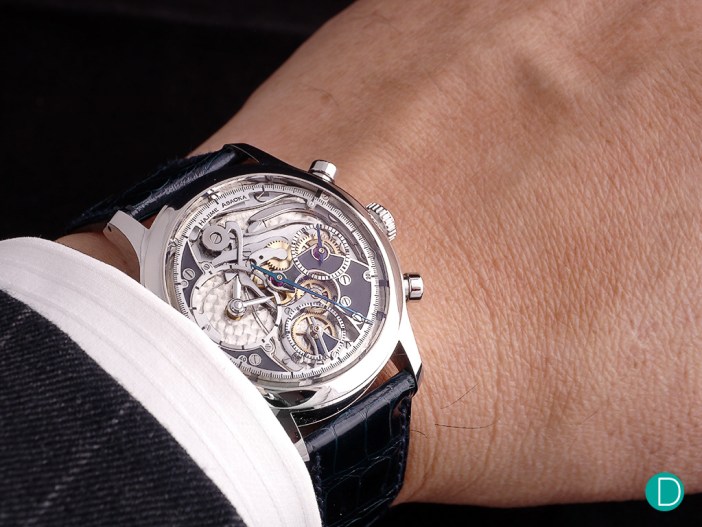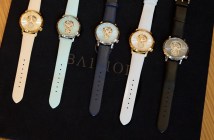Hajime Asaoka first burst into the haute horologie scene in 2014. More or less creating tsunami sized waves in the industry with his Project T Tourbillon. This followed in 2015 with a three hand watch which he aptly named Project Tsunami. This Baselworld 2017, he returns to introduce his first, self designed, home made chronograph – The Asaoka Chronograph! Quite a remarkable feat, as the chronograph is considered by many horology experts to be at or near the pinnacle of the art.
Hajime Asaoka taught himself the craft of watchmaking from the book by George Daniels – Watchmaking and from watching YouTube tutorials, and experimenting and building the watches with tools bought from eBay. Perhaps this is the brave new world, where everything is done online. But yet the craft of watchmaking is ages old, and the juxtaposition of teaching oneself via the most modern way possible to create traditional timepieces is interesting. And impressive. Especially when Hajime does not speak English, and the Daniels’ book is written in a terse, text book like language. Interesting too that he is able to translate YouTube tutorials into practical techniques. And even more impressive is that the final result is a watch which can rival any the industry can offer. Most spectacular indeed. From the Project 1 Tourbillon first shown in 2005, to the various Tourbillons and the simple three hand Tsunami. All carry impressive workmanship, exceptional show of virtuosity, and brilliance in execution. Each bear the idiosyncrasies of the man himself, which makes it all the more intriguing.

Hajime Asaoka with his Chronograph.
The Project Tsunami legacy
The Project Tsunami is a simple three hand watch and forms the base for the chronograph. The Tsunami is created in a 37mm diameter case featuring a huge 15mm diameter balance wheel. The Tsunami’s huge barrel carries a powerful mainspring in a relatively small case. The technique envisioned by Hajime to solve the problem of the huge mainspring barrel is to move the second wheel to the 9 o’clock position. This will result in the time indication of hours and minutes in a sub-dial at 9. But yet, in the Tsumani, the time indication is the same as in a regular watch, pivoted from the center. He used the space on the dial side to install additional wheels to move the de-centered position back to the center of the dial. And he also placed the balance wheel on a different level as the movement train.
The Asaoka Chronograph
For the chronograph, he used the Tsunami as the base, and instead of moving the de-centered hour/minute indication back to center, he left them in place as a sub-dial at 9. And used the space previously occupied by the train to re-center the time indication for a dial side for the chronograph works. The chronograph works is entirely new, and built from ground up.
The case, dial and hands
The case remains rather petite, and reflective of what is popular in Japan. The diameter is only 38mm, and the height of the case is 11mm. The case of the prototype shown here is made in Stainless Steel.

The case is 38mm diameter and 11mm high, and is also made by Hajime himself in his workshop in Tokyo.
The design brief (self brief if there ever was one), called for a traditional chronograph: column wheel, two button activation, with horizontal clutch system and an instantaneous minute counter. The entire operations of the chronograph works can be viewed from the dial side. As a classical chronograph, the movement is fitted with a column wheel which features a black polished cap. And a traditional horizontal clutch system.

The Hajime Asaoka Chronograph. A true, magnificent piece of horological art.
The dial features some rather idiosyncratic marks that Hajime leaves behind for the viewer to discover. One is the distinctly Art Decor style hour and minute hands, taken from Asaoka’s earlier creations, perhaps miniaturised to fit the sub-dial. Another is the interesting nod to the Japanese origins. The bridges on the dial side are coated with black Japanese laquer. Presumably, other colours may be specified. This gives a rather interesting aesthetic effect to the watch. It seems like the bridges are taking a step back from the stage, to allow the brilliantly polished chronograph works to take the place of pride. It reminds us of the curtain call after a particularly successful opera, when the cast takes a step back amidst the applause, and allow the prima donna soprano to soak in the glory under the main stage lights.
The dial side layout does make the watch look a bit complicated, but legibility is fair, and the ability to see the chronograph working without having to take the watch off the wrist is quite a mesmerising way to pass the time for the watch enthusiast.
The movement
All the action on the movement is showcased on the dial side, and the entire chronograph works can be seen. As prototypes go, the movement finish is quite good. With good attention to detail in the anglage, perlage and other haute horologie elements. And given that Hajime has proven his ability to rigorously and competently execute a high end haute horologie style finish, we are expecting the final watch to be even more spectacular.

The entire chronograph works is visible from the front. And as the watch is designed with the chrono module from ground up, the prime real estate is taken up by the chronograph and the hour and minute hands are relegated to a sub-dial at 9.
According to Hajime, the huge barrel and mainspring is able to keep the large balance in a steady equilibrium and as a result, the lost of amplitude with the chronograph on is less than 10°.
In operation the feel of the pushers at start/stop/reset is smooth and light, but with a positive click with each action. Quite satisfying. There is a small jump of the chronograph seconds hand on activation as is rather typical of chronographs featuring a lateral clutch system.

The dial is open worked to show case the beautifully shaped chronograph works. Visible here is the capped column wheel, very traditional design of a lateral clutch, and perhaps the Japanese touch of using lacquer to cover some of the bridges.
From the case back the Tsunami styled movement is visible. The huge, 15mm balance wheel in its tri-legged bridge is impressive to view. Especially when the balance beats at the traditional 18,000 bph. Perhaps there is something primal about the 18,000 bph rate. This translates to the balance executing 150 full oscillations per minute…about the heart rate of a human in a state of excitement or arousal. Might this be more than just co-incidence that many of us love the slow beat, traditional movement?

The rear of the case is rather plain safe for the exceptional finish, and the bridge with its huge balance, measuring some 15mm in diameter.
Competitive Landscape
Dial side chronographs are by no means unusual. The Venus 140, developed in the 1930s was probably the first to feature this. On the Venus 140, the second hand is omitted and the chronograph is a monopusher. Contrary to what some believe, monopushers are easier to manufacture than one with two pushers, and Hajime wanted to take the challenge of having to design and realise the traditional two button chronograph.
In the modern competitive landscape, perhaps the Louis Moinet Memoris (S$124,800 in gold, limited edition of 20 in white gold and 20 in rose gold, as reviewed. A regular production Memoris is also available in rose gold at S$89,900 and in white gold at S$99,800) is a good one. It is a monopusher, and the entire chronograph works is shown on the top half of the dial. The time indication being at 6 o’clock. The column wheel takes pride of place at 12. The Memoris is an automatic winding watch.
Another might be the Lange Datograph Auf/Ab. (S$124,000 in platinum). The Lange is of course the de facto standard for the modern chronograph, and one to be benchmarked against. It is manually wound, and features an instantly jumping minute counter. The chronograph works is not on the dial side, but is magnificent and can be viewed from the case back.
A possible monopusher inhabiting the landscape might be the Vacheron Constantin Harmony Chronograph (S$ 105,6000 in rose gold). Vacheron’s first in-house chronograph movement makes its debut in this monopusher in the Harmony series. The aesthetics are much more sober and classical. A full dial is featured, and the chronograph works can be viewed from the case back.
Concluding thoughts
The ¥ 12,000,000 price tag translates to roughly S$145,000. For a steel cased watch, this may be seen as perhaps high, especially in the light of the other competitive offerings discussed in the Competitive Landscape section which are all offered in precious metal cases. But consider this also. A chronograph, designed and manufactured solely by one man. A chronograph which is aesthetically pleasing, teasing the senses as it were with its tantalising dial side display. A chronograph which is beautifully finished with the touches of a master, and not mass produced in a factory. The proposition picture changes a bit.
The Asaoka chronograph is a limited edition of only three pieces, though in a discussion we had with Hajime, he hinted that he may increase the number of pieces depending on demand.

On the wrist the watch feels comfortable, and sits well. Despite being a prototype finished just before the show, the watch is stunning, and a masterful blend of aesthetics and technical showcase.
And as for us, and many of our hard core collector friends who had the opportunity to see the watch in Baselworld, we are impressed. And perhaps besotted. A little (if that is indeed possible). And we want to encourage Hajime. 頑張って! Ganbatte!
Asaoka Chronograph Specifications and Price
Two button chronograph with column wheel and carrying arm
Case diameter: 38mm
18,000 bph
21 jewels
Power reserve: 40 hours
Case material: Stainless Steel
Price: ¥ 12,000,000 (before taxes. Japanese clients will have to add Japan VAT and overseas clients will have to add shipping)
Limited Edition: 3 pieces.





1 Comment
Looks cool. I’ll take two.